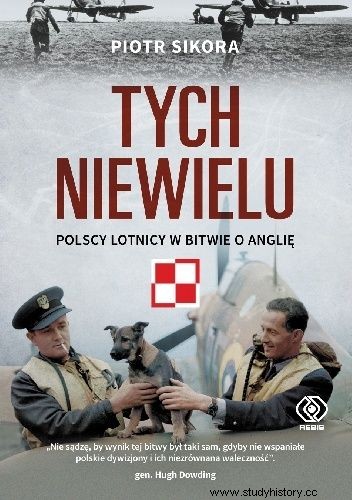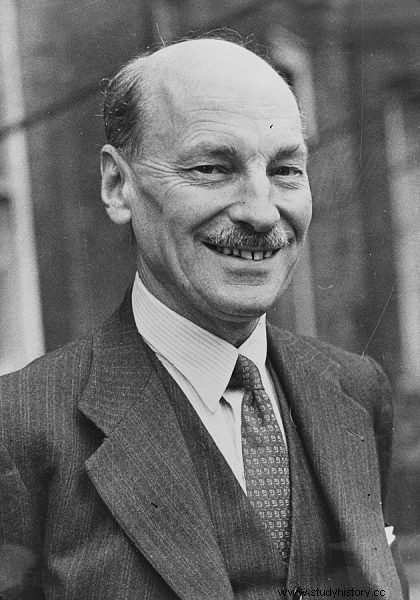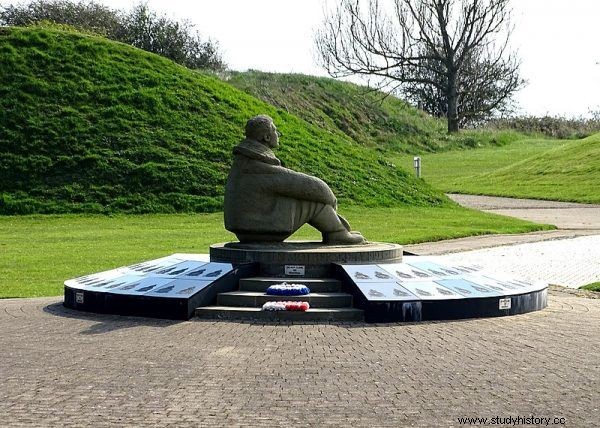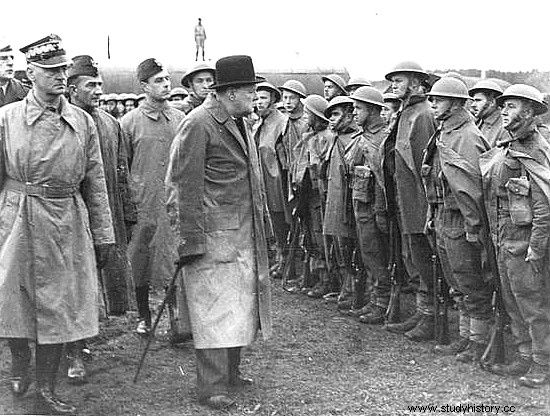Although the Poles played a significant role during the Battle of Britain, the island history forgot about them. Even in Poland, the famous 303 Squadron is known mainly thanks to reading in high school ...
A few years ago, one of the British political parties placed on its leaflets the famous Supermarine Spitfire, an important and emotional icon of British history, an incomparable defender of its independence and an ideal symbol of the nation's steadfastness. This image was supposed to represent the indigenous British traditions and values, referring to the national pride of the British, but above all to illustrate the intransigent policy of the party (I will not mention the name of which only because its members have a total right to different views and opinions) in relation to immigrants from some countries, including Poland. However, someone did not do the job.
Spitfire - British or Polish?
Major Jan Zumbach, commander of the Polish 303 Squadron, usually flew in the plane with the number RF-D, shown on glossy paper. On the smooth, shapely nose of the machine, the distinctive and unmistakable white and red sign of the Polish Air Force was clearly visible. Of course, one could say:these foreigners used our wonderful planes, which we kindly agreed to lend them, so that they could fight not only for our freedom, but also for the liberation of their homeland. So it seems that there is no problem:they are our debtors. But is it really?

The article is an excerpt from the book by Piotr Sikora Tych nielu. Polish airmen in the Battle of Britain , which has just been released on the market by the Rebis Publishing House
After the end of World War II, the Polish government-in-exile, which was beginning to be not so much inconvenient but even embarrassing for the British Prime Minister Clement Attlee, received a bill of over £ 107 million. This sum was to cover all expenses related to the activities of the Polish Air Force in Great Britain. In short, Poles should pay for every bomb dropped on German targets, every missile fired at a common enemy; each donned uniform and each button sewn on the same uniform, each eaten slice of bread and each dressing for the wounded.
So was this Spitfire more British or Polish? Surprisingly, when in 1993 in Capel-le-Ferne near Folkestone the monument to the Battle of Britain was unveiled, it lacked the emblems of the Polish 302 and 303 squadrons included in the original design. However, ironically, as a result of the subsequent correction of this error, these badges gained a central and fully deserved place on the monument. It is impossible to overlook them.
After much reflection, I decided to introduce readers to similar, somewhat controversial cases, not to put a stick in an anthill, but to show how much still needs to be done to avoid such harms in the future, caused deliberately or out of ignorance. In fairness, both sides are to blame.
Mistakes and controversies
In 2005, the Polish Tourist Organization in London promoted its campaign entitled "Londoners, we are with you again!" (Londoners, we are with you again!) A poster showing the pilot standing next to the Hawker Hurricane plane, with the PSP sign painted in the form of a white and red checkerboard.
Again, someone didn't do their homework. Unfortunately, important information about the pilot was overlooked, who turned out to be Captain John Kent instead of a Pole, a Canadian fighter ace serving in the RAF, and later in the Polish squadron.
Another example? In the popular Polish song To us - Dywizjon 303 , written after the war, there are the words "Polish signs shine on our wings" (This is us - 303 Squadron Airmen March, words by Czesław Kałkusiński, music by Henryk Fajt. The song was written in 1944 - source:Digital Library of Polish Song; transl.). The fact that the Polish Air Force was using British planes with RAF ribbons on both lobes was completely ignored. In fact, we do not currently have any evidence of the presence of Polish marks on the machines of 303 Squadron during the Battle of Britain.

After the end of World War II, the Polish government-in-exile received a bill of over £ 107 million from the Cabinet of the British Prime Minister Clement Attlee
Much still needs to be improved in this field, both in Poland and in Great Britain. Unfortunately, half a century of the existence of the Iron Curtain, which divided Europe by building the image of poor Eastern European neighbors, successfully fulfilled its task. In the absence of more detailed information, the average Brit does not know much about Poles flying from Great Britain, flying alongside the Royal Navy on their own ships, or fighting with the British Army in Africa, Italy or Western Europe.
It still seems strange that as many as 17,000 men and women of the Polish Air Force served during the war under British command for which the United Kingdom was a temporary and only home. On the other hand, most of the Kowalski and Nowak families who live over one and a half thousand kilometers from here in Poland, most often have no idea about the scale of Polish involvement in the Allied forces in the West. This is the result of communist censorship.
Polish merits in England
Poles, if they know some basic information about Squadron 303, owe it only to the novel by Arkady Fiedler, Squadron 303, written in 1942, which is obligatory reading in Polish schools. These people, the present adult generation of free Poland, and even more disturbingly also the youth, have no idea of any greater participation and achievements of Poles during the war. Perhaps the phrase "Battle of Britain" tells them something, but due to the name containing a geographical reference, it is associated with all operations conducted by the Polish Air Force from bases in Great Britain in 1940-1945, not with this one specific chapter of the war that had such a fateful impact on history.
It would be extremely optimistic to expect the British public to know the involvement of Poles in the Enigma and Ultra decryption programs or the bravery of the soldiers of the Polish II Corps, who in Italy in 1944 launched the decisive assault on Monte Cassino.
Who knows that the mine detector was developed by two Polish officers or that the Polish Home Army captured a long-range V2 missile and transported its components to Great Britain? What is our knowledge of the activities of the Polish Independent Carpathian Rifle Brigade during the defense of Tobruk in 1941 or the 1st (Polish) Independent Parachute Brigade, which saved the British paratroopers of General Robert Urquhart, surrounded in Oosterbeek during the tragic operation "Market Garden" in September 1944 ?

When in 1993 the monument to the Battle of Britain was unveiled in Capel-le-Ferne near Folkestone, the emblems of the Polish 302 and 303 squadrons were missing. It was only later that Polish squadrons were added
Are we aware that there was someone like Roman Czerniawski? This Polish airman as a double agent, "Brutus" and "Armand", played a key role in misleading the Germans about the Allied landing site in France in 1944. How much has been said about the Polish squadrons with the most victories in the disastrous rally at Dieppe in 1942?
After the conferences in Tehran, Yalta and finally Potsdam, where the fate of Great Britain's most faithful ally was sealed, the infamous removal of Poland from the map of the post-war world made it very difficult for people to stay true to the truth; therefore, all the above-mentioned achievements were almost buried in oblivion. It is true that in the summer of 1940, faced with heavy losses, the Fighter Command, the Fighter Command, and General Hugh Dowding at its head, struggled to find qualified flying personnel capable of facing the overwhelming power of the German Luftwaffe.
Polish pilots in action
With all resources exhausted, and even manning fighter planes with bomber pilots, the RAF desperately needed experienced and battle-hardened airmen. And just such people came from Poland, who had two campaigns under their belt:the first in their homeland, in 1939; the second in France in 1940.
Having experienced terrible tragedies in their native skies, Polish pilots wanted to fight again. Contrary to some sources, incorrectly claiming that the war in Poland was lost within a few days or even hours of the German attack, Poles fought for their country long and fiercely enough to fully familiarize themselves with the tactics used by the enemy. The Germans got to know the skills and determination of Polish pilots well, suffering relatively heavy losses. These Poles constituted valuable and well-trained military personnel. They gained experience in advanced combat tactics in Poland, including the famous and practical four-finger formation, often mistakenly attributed only to Germany.
Most of them also had the opportunity to pilot modern fighters while serving in France before its capitulation. The only obstacles that plagued the Poles were the language barrier and the specificity of operating British machines. Overall, the cockpit layout was completely different from what they were used to in Poland and then in France. They were also unfamiliar with imperial units of measurement; they did not know gallons, inches, feet, yards and miles, so very often they had to learn to recognize the differences from their mistakes, sometimes even at the cost of a hard landing.

Winston Churchill browsing Polish troops in England. During the war, as many as 17,000 men and women from the Polish Air Force served under British command
They also hated the British 'vic' tactic which they considered too risky. It is easy to describe the everyday life of Polish squadrons during the Battle of Britain on the basis of obvious sources, even if it is not a satisfactory description. However, it is much more difficult to be more accurate. It is relatively easy to trace the history of 303 Squadron, for example, because of its fame, growing popularity and almost cult status that he enjoys in Polish and even British culture and literature.
In addition to the operational journal, Operations Record Book, monthly reports on activities or reports, we have a well-known journal initiated by personal notes of Mirosław Ferić, which later smoothly turned into an official document. Undoubtedly, countless written memoirs, historical books, and often unknown stories, passed down by fathers and grandparents to future generations, also played an important role. Also, the photographic documentation of 303 Squadron's operations during the Battle of Britain is much richer thanks to its quickly gained popularity than that devoted to the second Polish squadron or individual pilots from that period.
In the case of the 302 Squadron, the state of knowledge is far from ideal, as a significant part of the operational data is missing. Few photographs have been preserved showing the pilots or the machines of the unit in this particular chapter of the war. Thanks to fragmentary accounts of 302 Squadron's participation in the Battle of Britain, published by its pilots, including Julian Kowalski, Wacław Król and Jan Maliński, we know much more not only about their responsibilities as a team, but also about personal emotions and quarrels between individuals.
Such materials allow authors and researchers to trace the history of both units more closely. RAF officials paid less attention to Poles who flew in British squadrons, if they had not shot down the enemy or were not thrown down themselves. They struggled with writing down their foreign names, often noting them incorrectly in the squadron's operational log. We can determine how often they took off from airports or participated in patrols or skirmishes with the enemy. We know less about where they were on a daily basis and what they struggled with.

The article is an excerpt from the book by Piotr Sikora Tych nielu. Polish airmen in the Battle of Britain , which has just been released on the market by the Rebis Publishing House
Those who left behind testimonies in the form of books or individual loose observations, for various reasons, were few. We learn more about their feelings, language problems and combat experiences in the firmament of Albion from their British comrades-in-arms who kindly deigned to mention these strange adventurers with Slavic names in their memoirs.
There is still a lot of work to be done by historians and researchers of British and Polish aviation as well as amateurs driven by sheer curiosity. Only a few specialists, affectionately known as "geeks", engage in direct research and exploration. As long as they can count on encouragement and support from governments, various organizations and individuals, there will still be light at the end of the tunnel. In my work, not only on this book, but in general research as well, I have been fortunate enough to receive the support of many people; thank goodness there were not "few" of them.
Source:
- The article is an excerpt from the book by Piotr Sikora Tych nielu. Polish airmen in the Battle of Britain , which has just been released on the market by the Rebis Publishing House
